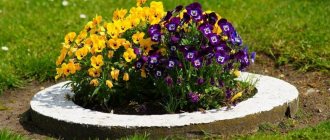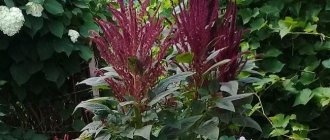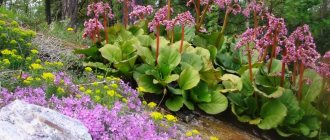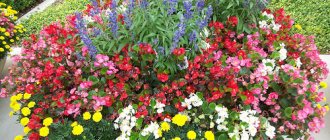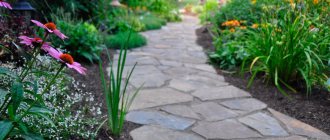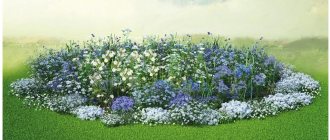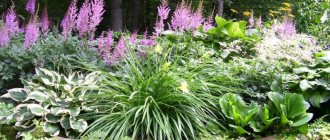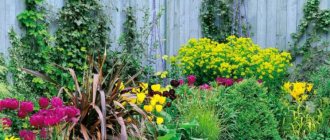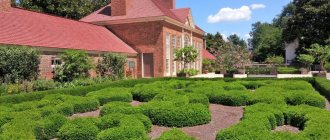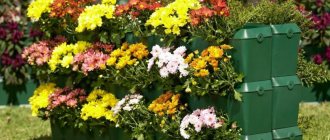Share this article:
For every person, a dacha is its own unique world, a place where you can relax from the bustle of the city and enjoy the colors of nature. To make this world more cozy and bright, we suggest you decorate your dacha with a flower garden created by yourself.
A flower garden is an area with ornamental plants where flowers, lawns, ferns, shrubs, conifers and even small trees are grown. At the same time, harmony should reign in the flower garden - crops should be combined in color, size, shape. In addition, it is necessary to take into account the development time and duration of flowering of plants.
Creating and designing a flower garden is a complex, time-consuming process that requires careful preparation, so before starting our work it is better to sketch out a plan for the arrangement of different varieties of flowers. This is especially necessary if you plan to place a complex flower garden on the site, where a clear pattern and ornament are very important.
Before making a flower garden, we decide a number of points
- We think over the type of flower garden, its shape, size, flowering period. We plan for the plants to either bloom at the same time, or after some flowers fade, others will bloom in their place.
- We study the growing conditions of crops: what kind of soil they need, humidity, lighting requirements - they should be approximately the same. In addition, there are plants that do not get along side by side or can crowd out other crops.
- We decide on the choice of plant variety and color scheme, based on our own preferences. Crops must harmoniously match each other in the color of leaves and flowers, and in terms of flowering time. You can also be guided by the principle of contrast: in color, shape and structure. However, keep in mind that too many contrasts in a flower garden will give it a disorderly appearance.
- Then we study the composition of the soil to find out what fertilizers to apply and whether this is necessary for the good development of crops.
Add or remove fencing
Wanting to achieve a natural style in the garden, many summer residents do not limit the flower beds, placing them in the middle of the lawn or in the tree trunk. Alas, it looks good only in the first couple of years, then weeds begin to penetrate into the protected area, and cultural plantings break free. As a result, the boundaries of the flower garden are erased, and it begins to look sloppy.
A low fence dug into the ground will help to avoid this, which will prevent the plantings from mixing and the flowerbed from losing its original outline.
True, there is another problem - incorrectly selected fencing. For example, these could be large stones that sink into soft soil, becoming a refuge for ants, or old pieces of slate and shabby boards that negate all the floral charm.
If you don’t know how to limit the flowerbed, give preference to a dug-in border strip or one of the aesthetic materials.
- Fences for flower beds
How to choose or make a beautiful fence for a flower bed with your own hands.
Proper care is necessary for a flower garden
- Regular watering, taking into account that a lack or excess of moisture can destroy the plants. On hot days, it is necessary to water in the morning before 8 o'clock or in the evening after 17 o'clock. It is better to use rain or river water. If you have water from wells, which is most often very mineralized, it must be left in a tank for at least a day. Otherwise, constant watering with unsettled water will lead to salinization of the soil, and the plants may get sick.
- Feed with fertilizers. In spring, the dose of nitrogen fertilizers should be increased. Superphosphate, potassium and ammonium nitrate are used.
- Pinch.
- Weed to destroy weeds and loosen, which will retain moisture in the root system and improve air exchange.
- Trimming. Dried stems and flowers, faded inflorescences must be trimmed. This will preserve the neat appearance of the flower garden, extend the flowering time, promote increased leaf growth and strengthen the plant roots. The exceptions are dried flowers and species with decorative fruits that will decorate the flower bed (poppies, brisa, barley, haretail, nigella, scabiosa).
Add fertilizer to the soil
A flower bed can also lose its decorative properties due to lack of nutrition, because plants need potassium and phosphorus to bloom, and they need to be added annually and preferably more than once a season. We don’t argue that there are unpretentious flowers that grow without fertilizing or on organic fertilizer alone, but these are in the minority. All of our usual garden decorations need to be fed in spring, summer and autumn, giving preference to complex mineral fertilizers.
- How to feed garden flowers in the fall so that they bloom magnificently in the spring
Let's talk about autumn feeding of your flower garden.
Types of flower beds
There is no generally accepted classification of flower beds, and it may vary significantly among different authors. There are several types of flower beds:
- Mixborder.
- Parterre.
- Rabatka.
- Front garden.
- Rockery.
- Water flower garden.
- Flowerbed.
Mixborder
This is an elongated flower garden of several rows of ornamental plants, usually of irregular shape, which are selected so that they bloom continuously from early spring until late autumn.
Make up a mixborder in this way:
- Tall woody or herbaceous plants and vines are planted near a wall, decorative hedge or fence;
- then herbaceous perennials and bulbous plants are placed in the middle part of the flower garden;
- in front are low annuals or perennials, ground covers (plants that quickly grow in width, forming a natural “carpet”).
Ornamental vegetables are often planted in the mixborder. For example, climbing asparagus beans, whose fruits are colored differently depending on the variety. A fringe of lettuce leaves and ornamental cabbage near carved carrot tops, parsley and onion feathers.
Parterre (ornamental flower garden)
This is a very complex type of flower garden in design and care with strict geometric shapes, consisting of several elements (decorative foliage and flower crops, lawns, paths, sculptures) combined into a whole.
The ground floor can also be arranged on a summer cottage. For example:
- The center of the parterre can be a small fountain, flowerpot or sculpture, molded thuja, barberry, standard rose, hydrangea, clematis.
- Vegetables, parsley, nasturtium, oregano, and thyme can be placed around.
- Using paths, we divide the space into sections of geometric shapes and plant the following crops to suit our taste: basil, tarragon, caraway, dill, coriander, mint, lemon balm, sage.
- Tall plants are placed at the edge of the site.
- Climbing plants look good near the fence: woody tecoma vine, decorative beans, morning glory, sweet peas.
Rabatka (flower bed)
This is an elongated flower garden similar to beds, where plants are planted in the form of a rectangular strip or wave along garden paths and buildings. They have a length from two to several tens of meters. The most common width of such a flower bed is 1–1.5 meters, but can be from 0.5 to 4 meters.
Works that are too long can be intermittent or continuous. The intermittent ridge is broken every 3–10 meters, depending on its total length, into small square or round flower beds and paths.
If the ridge is one-sided (asymmetrical), then plants of different heights are arranged with a ladder. In a double-sided (symmetrical) ridge, the tallest crops are planted in the center.
For the rabatka, carpet, bulbous or annual and perennial decorative foliage plants are selected.
Front garden
This is a fenced area in front of the house with a path leading to it.
Often, the front garden composition is formed in such a way that two dominant plants are planted on opposite sides of the path and supplemented with smaller crops. Fruit trees and tall plants are also planted in the front garden. If there is a road near the dacha plot, then they will protect from noise and dust. For a front garden, it is better to use a low and neat fence made of natural materials: wicker, wood, stone or a hedge (made of lilac, barberry, hawthorn, juniper, wild grapes).
Rockery (rocky garden)
This is a space where ornamental plants are combined with relatively large stones.
When creating a rocky garden, you must try to arrange the stones naturally, asymmetrically, so that they have the appearance of a natural corner, without oversaturating it with decorative elements. It is important to choose plants and stones in such a way that they emphasize the beauty of each other.
Low-growing shrubs (especially from the Heather family), ground covers, and cushion-shaped plants (aubrieta, pterygophyte, Iberian, alpine flax, cushion-shaped phlox, and others) are planted in rockeries. At your summer cottage, you can arrange a small rocky garden in the form of a horizontal plot or a hill, as well as a mini-garden in a stone flowerpot.
water flower garden
This is a flower garden with a pond, framed by stones, in which aquatic plants grow, and around it - coastal species. Depending on your own preferences and the area of your dacha, you can build a mini-pond, a fountain, a decorative waterfall, or a spring with a stream.
Suitable materials for building a water flower garden include concrete, waterproofing film, wild stones or cobblestones, plastic, metal barrel, and the like.
You can also create a water flower bed: stationary, fixed in a certain place, or freely moving through the water, floating.
When constructing a fixed flower bed in a pond, it can be made large by placing it on a stable column made of brick, stone or concrete that does not protrude above the water.
A flower bed that moves freely through the water can be made from small plastic containers: basins, bowls, cut plastic bottles. Such a flower bed should be light in weight in order to float on the water. You can use hydroponics - this is an artificial medium in which plants are grown, which has less weight than soil. This water bed is quite simple to make and can be removed or replaced at any time.
Flowerbed
This is a small flower garden, usually rising above ground level (at the edges by 10 cm, and in the center by 30–40 cm), with a strict geometric shape in the form of an oval, circle, square, rhombus, rectangle.
In a flower bed you can plant one or more types of annual, biennial and flowering bulbous plants of different colors so that they form a pattern or design. Less commonly, the ornament is made from perennial plants.
The flowerbed is placed in an open area so that it can be viewed from any side. It will look especially good against the backdrop of a green lawn.
Flowerbeds can be of several types:
- Arabesque is a carpet or mosaic flowerbed; to create it, carpet plants with colored, variegated foliage (sedum, alternanthera, oxalis, gnafalium, santolina), annual and perennial flowers, as well as sand and small pebbles are used. The ornaments are made in the Arabic manner and resemble garlands, leaves, flowers, various curls, butterflies, wreaths and other designs in their contours and appearance. Arabesques decorate the edges and corners of parterres, lawns and other flower beds. The resulting patterns are very similar to an oriental carpet.
- A regular flower bed with clear boundaries between plantings has a strict geometry of patterns made up of plants that will begin to bloom and fade almost simultaneously. The latter is a distinctive feature of a regular flower bed.
- Irregular flower bed - crops are planted in small groups, selecting varieties so that they bloom in turn, overlapping each other when flowering. While some species are fading, others are just beginning to bloom.
- A monoflower is the simplest version of a flower garden, consisting of plants of only one species. For example, this is how you can create a rose garden.
Knowing the principles of organizing different types of flower beds, you can independently select plants according to height, color and flowering time. As an example, we give some types of crops and compositions made from them.
Rule 1
Assess the environmental conditions of the site .
This is the first place to start planning your plantings. To begin, try to determine as accurately as possible the type and structure of the soil on your site (dry, moist, sand, loam, etc.). Don't forget about soil acidity! Pay attention to another important condition - the lighting mode. Observe which part of the site has the most sun, how the shadow passes over it during the day, where there are shaded areas. If you can correctly assess the situation, you will definitely save your time and money, because plants planted in unsuitable environmental conditions will sooner or later die (or develop poorly). Assessing the environmental conditions of a site is the first place to start planning plantings. Buzulnik, astilbe, hosta, Rogers, and ferns are suitable for wet shade. Plants for dry sunny places: sedum, echinacea, angustifolia lavender, sage, catnip. Plants for acidic soils - rhododendron, azalea, heathers, cranberries, lingonberries.
Selection of plants by height
- Low-growing: adonis vernacular, arabis, pansy, periwinkle, Iberian, Carpathian bellflower, pterophyte, forget-me-not, saxifrage, poppies, aubrieta, primrose, petunia, Lydian and white sedum, cushion phlox, hosta, edelweiss.
- Medium: aquilegia, aster, cornflower, elecampane, swimsuit, delphinium, bellflower, daylily, oriental poppy, narcissus, peony, tulip, phlox, ash.
- Tall: Japanese anemone, yellow hepatica, asparagus, iris, mallow, groundsel, cornflower, foxglove, chrysanthemum, echinacea.
Rule 4
Consider flowering times .
When you have worked through the first three points and selected suitable plants, make a flowering table. In the vertical column write all the plants in order, and in the upper horizontal column write the months, from April to November. Place a check mark at the intersection of the type of plant and the months in which it blooms (many bloom over several months). After filling out the entire table, you will immediately understand whether you have chosen the right assortment to ensure continuity of flowering or whether you should further refine the list. When creating a flower garden, be sure to take into account the timing of flowering plants. As a rule, the most difficulties arise with the selection of flowering plants for April-May and September-October. For early spring you can choose anemones, doronicums, primroses, mountain weeds, and aubrieta. To prolong autumn flowering, plant chrysanthemums, sedums, heleniums and perennial asters.
Selection of plants by color and shape
- Spring Bloomers: Perennial Daisy (white) and Japanese Quince (red).
- Alpine Arabis (white) and tulips (multi-colored).
- Brunnera macrofolia (blue) and tulips (multi-colored).
- Magnolia holly (yellow) and dwarf iris (multi-colored).
- Low almond (pink) and spring adonis (yellow).
- Alpine forget-me-not (blue) and oriental doronicum (yellow).
- Alpine forget-me-not, daffodils, tulips - a contrasting combination.
- Aubrieta dissected (red-violet) and daffodil hybrid (yellow).
- Perennial daisy (white, pink, red) and primrose finetooth (purple).
- Saxifraga thick-leaved, spring primrose and St. John's wort spirea are a contrasting combination in shape and color.
- Scylla sibirica (bright blue) and rock alyssum (yellow).
- Creeping Phlox (pink) and Evergreen Iberis (white).
- Creeping phlox (pink) and grape muscari (white and blue).
- Hosta (with rounded leaves) and Arends' astilbe (towering panicle inflorescences).
- Chrysanthemum (yellow, pink, white) and bush aster (lilac, white).
Typically, in summer cottages, beds and flower beds are located separately. But you can create a flower garden in which vegetables, flowers and aromatic crops will be mixed. This will diversify the boring world of vegetable beds, making them incredibly interesting.
Even an ordinary garden bed with diagonal rows, on which carrots, chives and a couple of types of salads are planted in turn, will turn into an original and useful flower garden. Such mixed beds are a good way out of the situation if there is not enough free space at the dacha to plant a large flower garden.
Herbs and flowers go well together: marjoram with cloves, thyme with crocus. In addition, we will receive not only beauty, but also the extraordinary aroma of spicy aromatic herbs: peppermint, lemon balm, oregano, rosemary, sage, thyme, basil, coriander. You can form interesting compositions only from spices: lovage and oregano, savory, marjoram and thyme; amaranth, basil, borage.
When choosing crops for your flower garden, be guided by your taste and preferences. You don’t have to be a landscape designer to create interesting and unusual compositions from different types of plants. Even small flower beds near the house, near the gazebo and along the paths will delight you. A little patience, and your dacha will be decorated with a unique fragrant flower garden that will heal you from fatigue, lift your spirits and bring a touch of lightness to your life.
Related articles:
- Lawn for a summer residence: planting and care How beautiful the green paths in front of the alpine hills or flower beds with bright flowers in the middle of the green lawn look. Everyone would like to have such a place for relaxation and […]
- Video surveillance for a private home The freedom and comfort that a private home gives to the owner is truly an indescribable feeling. In addition to caring for the cottage and yard, ensuring its safety is becoming increasingly [...]
- Plastic bottles: crafts for the garden An ingenious invention of the 20th century - a plastic bottle. You won't see her anywhere! In schools, at an exhibition of children's crafts, on the porch of any administrative building in the form of a bird feeder. […]
- Do-it-yourself garden shed Perhaps not a single suburban area is complete without outbuildings. Having a utility room in your country house is simply vital. After all, outbuildings are not only [...]
Rule 2
Choose the style of the flower garden . Depending on the chosen style, you will create an assortment of plants. This rule is important to consider in order to create a harmonious composition that will fit perfectly into the garden space and help express your idea to the maximum .
There are many different styles and trends, among which several of the most common can be identified - natural, shady, rocky, English, romantic, country, Mediterranean, garden, etc. The range of plants in the flower garden depends on the chosen style. If you want to create a romantic flower garden, use plants in delicate colors, simple in appearance. Peonies, decorative onions, geraniums, speedwells, roses, sages, and bells are suitable for this. Stop your choice in shades of white, blue, pink and lilac. Such a flower garden will look especially impressive in light partial shade.
In a romantic flower garden, use plants in delicate colors that are simple in appearance.
Rule 8
Include bulbous plants in the composition. Taking into account the different flowering times, you can plan their flowering from spring to autumn. In early spring you will be pleased with crocuses, pushkinias, chionodoxa, and scilla. Tulips, daffodils, hazel grouse and hyacinths, depending on the type and variety, bloom from May to June. In June, the accent will be various decorative bows, in the middle and end of summer - lilies and gladioli. Crocosmia and crocus bloom in autumn. Bulbs need to be planted in large groups side by side so that there is a feeling of a bouquet, a large spot of color
Flowerbed design
You won’t surprise anyone with simple flower beds. Plants are planted not only in open ground, but also in various objects raised above the ground. They are often made in the same style as a terrace, veranda, swimming pool, or the nearest building. In just a couple of hours, any item that has been collecting dust in the barn can turn into an original landscape design object. The following types of flower beds can decorate your garden:
- Regular. Plants are arranged symmetrically, tightly, in even blocks. Flowers must have one flowering period and height. Hybrids are more suitable for this purpose;
- Irregular. A free-form flower garden with perennials that bloom alternately throughout the season;
- Carpet. The close arrangement of low-growing plants creates a carpet effect. Various inert materials (pebbles, sand) will help create a clear pattern. The most popular design example is the flower clock;
- Elated. A non-standard flower garden is raised above the ground by 20-100 cm. It can be in one or several tiers. A combination of ground cover and tall plants is possible;
- Vertical. Used to save space. Place it on the ground, hang it, attach it to any surface. The main advantage of this design is that there is no need for weeding;
- Multidimensional. The unusual flower garden is located not on a plane, but in volume. To create compositions, auxiliary structures are used. For example, a flowerbed made from an inverted umbrella, on a chair, in a cart;
- Ring. They are located in a ring around an object (tree, bush, large stone). To prolong the bright color, plants alternate according to the flowering period;
- Ostrovnaya. Includes plants of varying heights. The tallest perennials are in the center, low-growing along the edges;
- Flowerbed-panel. A complex flower garden resembles a carpet bed and reflects a specific image or inscription;
- Modular. In one space, flower beds unite individual areas with one concept. They are separated by slabs and paved paths.
Rule 9
Complete the flower garden with annuals . If the garden is still young and there is a lot of free space between plantings, feel free to fill it with annual flowers. Choose plants that suit your style. They will help create the feeling of a complete, mature garden. And if you have planned a monochrome flower garden, then annuals will be an excellent addition to the existing plants and will maintain the desired color for a long time. Antirrinum, cleome, zinnia, and scabiosa are suitable for these purposes. For the foreground you can use purslane, verbena, and eschscholzia. Free space in a young garden can be filled with annual plants
Creating a continuously blooming flower bed
The main advantage of such a flower bed is durability. It will decorate the area with bright color all season long. You will have to spend money on purchasing seeds once. Such plants do not require additional care or frequent feeding, since they do not deplete the soil. You can choose any place for planting, but in a sunny zone, development and flowering will be more intense.
To achieve maximum picturesque effect, it is not at all necessary to plant many different varieties. For a continuous flowering flower garden, 5 types of perennials will be enough. The first group blooms in early spring. These can be crocuses, tulips, daisies, peonies. In summer they are replaced by roses, hibiscus, lilies, echinacea, and hydrangea.
Calm, noble color envelops the flowerbed with the arrival of autumn. During this period, phloxes, cannas, and carnations open their buds. Until the very frosts, coniferous evergreen perennials, tree-like ornamental plants, and golden spheres of craspedia will delight the eye.
Rule 6
Think about the structure. This is an important component of any garden composition, including a flower garden. It is necessary to create a “skeleton”, the basis of the plantings. Perennial plants that are stable from spring to autumn are suitable for these purposes. This means that they form a dense bush, do not fall apart , and after flowering do not lose their decorative effect. Structural plants can “support” their neighbors, or cover temporarily formed voids after trimming some flowers (delphinium, oriental poppy, lupine) until they form a new rosette of leaves. Skeletal plants include peony, bearded iris, etc. Siberian, astilbe, hosta, daylily. Perennials, which are stable from spring to autumn, make up the main structure of the flower garden.
Rule 10
Take care of your plants. In order for your compositions to always be healthy and look good, they need timely care. Remove faded inflorescences in a timely manner against diseases and pests.
Purchase the necessary medications in a timely manner and carefully monitor your plants. Most importantly, don’t forget to take pictures of your garden! It changes throughout the season and becomes even more beautiful from year to year. Capture these moments in the life of your garden and enjoy the results of your labor. We remind you that there will be no homework in all Landscape Design School lessons. However, there is no need to relax! At the end of the training course, you will be tested for knowledge - a final exam on all topics.
You can purchase plants for creating flower beds and mixborders at the nursery of Agroholding POISK.
- Trees and shrubs : hydrangeas, weigelas, cinquefoils, spirea, rhododendrons and others.
- Perennial flowers : saplings, loosestrife, hostas, coneflowers, speedwells, astilbes, daylilies, peonies, irises, heucheras, ornamental grasses and others.
- Annual flowers : cleomes, zinnias, scabiosa, purslane, verbena, eschscholzia.
- Bulbous : tulips, daffodils, hazel grouse, hyacinths, scillas, crocuses, lilies, gladioli, colchicums, chionodoxes, pushkinias.
- Ground cover plants : thyme, herbaceous carnation, periwinkle.
Rule 5
Don't forget about height and tiering. If you plan to create a composition with a one-way view, then the tallest plants can be planted in the background and gradually move on to shorter plants in the middle and foreground. If your planting will have a comprehensive, or all-round, view, then the tallest plants should be placed in the center. Important
: all planted plants should create a feeling of naturalness, each new group should appear from the volume of the previous one.
There is such a concept - “closed legs” .
So this is precisely the principle that must be used when planting. For example: we plant a monarda, in front of it is phlox, and in front of the phlox is catnip, which will lie in a spreading cloud on the lawn or path, covering the “legs” of the phlox. Conventionally, we can divide the entire range of plants into background, middle and foreground plants. The tallest (120-180 cm): sapling, New Belgian asters, delphinium, reed grass, veronicastrum, loosestrife.
The middle ground (50-100 cm) is the main assortment of garden flowers: echinacea, sage, speedwell, astilbe, phlox.
Conventionally, the entire range of garden crops can be divided into plants of the background, middle and foreground
And the foreground (20-40 cm) is the shortest species: mantle, heuchera, low-growing hostas and daylily, chickweed.
Foreground plants have a height of 20-40 cm
Ground cover plants do not take height into account, but they can be an excellent transition from a flower garden to a lawn or path. Plant thyme, awl-shaped phlox, sedum, carnation grass in the sun, and in the shade - tenacious, hoofweed or periwinkle.
Ground cover species help make a smoother transition from flower garden to lawn or path

